Ordovician
The Ordovician (/ɔːr.dəˈvɪʃ.i.ən, -doʊ-, -ˈvɪʃ.ən/ or-də-VISH-ee-ən, -doh-, -VISH-ən)[2] is a geologic period and system, the second of six periods of the Paleozoic Era. The Ordovician spans 41.6 million years from the end of the Cambrian Period 485.4 million years ago (Mya) to the start of the Silurian Period 443.8 Mya.[3]
| Ordovician Period 485.4–443.8 million years ago | |
| Mean atmospheric O 2 content over period duration |
c. 13.5 vol % (68 % of modern level) |
| Mean atmospheric CO 2 content over period duration |
c. 4200 ppm (15 times pre-industrial level) |
| Mean surface temperature over period duration | c. 16 °C (2 °C above modern level) |
| Sea level (above present day) | 180 m; rising to 220 m in Caradoc and falling sharply to 140 m in end-Ordovician glaciations[1] |
Epochs in the Ordovician -485 — – -480 — – -475 — – -470 — – -465 — – -460 — – -455 — – -450 — – -445 — – Epochs of the Ordovician Period. Axis scale: millions of years ago. | |
The Ordovician, named after the Welsh tribe of the Ordovices, was defined by Charles Lapworth in 1879 to resolve a dispute between followers of Adam Sedgwick and Roderick Murchison, who were placing the same rock beds in northern Wales into the Cambrian and Silurian systems, respectively.[4] Lapworth recognized that the fossil fauna in the disputed strata were different from those of either the Cambrian or the Silurian systems, and placed them in a system of their own. The Ordovician received international approval in 1960 (forty years after Lapworth's death), when it was adopted as an official period of the Paleozoic Era by the International Geological Congress.
Life continued to flourish during the Ordovician as it did in the earlier Cambrian period, although the end of the period was marked by the Ordovician–Silurian extinction events. Invertebrates, namely molluscs and arthropods, dominated the oceans. The Great Ordovician Biodiversification Event considerably increased the diversity of life. Fish, the world's first true vertebrates, continued to evolve, and those with jaws may have first appeared late in the period. Life had yet to diversify on land. About 100 times as many meteorites struck the Earth per year during the Ordovician compared with today.[5]
Dating: extinction events
The Ordovician Period began with a major extinction called the Cambrian–Ordovician extinction event, about 485.4 Mya (million years ago). It lasted for about 42 million years and ended with the Ordovician–Silurian extinction events, about 443.8 Mya (ICS, 2004) which wiped out 60% of marine genera. The dates given are recent radiometric dates and vary slightly from those found in other sources. This second period of the Paleozoic era created abundant fossils that became major petroleum and gas reservoirs.
The boundary chosen for the beginning of both the Ordovician Period and the Tremadocian stage is highly significant. It correlates well with the occurrence of widespread graptolite, conodont, and trilobite species. The base (start) of the Tremadocian allows scientists to relate these species not only to each other, but also to species that occur with them in other areas. This makes it easier to place many more species in time relative to the beginning of the Ordovician Period.
Subdivisions
A number of regional terms have been used to subdivide the Ordovician Period. In 2008, the ICS erected a formal international system of subdivisions.[6] There exist Baltoscandic, British, Siberian, North American, Australian, Chinese Mediterranean and North-Gondwanan regional stratigraphic schemes.[7]
| ICS Epoch | ICS stage | British epoch | British stage | North American epoch | North American stage | Australian epoch | Australian stage | Chinese epoch | Chinese stage |
|---|---|---|---|---|---|---|---|---|---|
| Late Ordovician | Hirnantian stage | Ashgill series | Hirnantian stage | Cincinnati series | Gamach stage | Late Ordovician | Bolinda stage | Late Ordovician | Hirnantian stage |
| Katian stage | Rawthey stage | Richmond stage | Chientangkiang stage | ||||||
| Cautley stage | Maysville stage | Easton stage | Neichiashan stage | ||||||
| Pusgill stage | Eden stage | ||||||||
| Caradoc series | Strefford stage | Mohawk stage | Chatfield stage | ||||||
| Cheney stage | |||||||||
| Sandbian stage | Burrell stage | Turin stage | Gisborne stage | ||||||
| Aureluc stage | Whiterock stage | Chazy stage | |||||||
| Middle Ordovician | Darriwilian stage | Llanvirn series | Llandeilo stage | Middle Ordovician | Darriwilian stage | Middle Ordovician | Darriwilian stage | ||
| Abereiddy stage | Not defined | ||||||||
| Dapingian stage | Arenig series | Fenn stage | Early Ordovician | Yapeen stage | Dapingian stage | ||||
| Whitland stage | Ranger stage | Castlemaine stage | |||||||
| Ibex series | Black Hills stage | Chewton stage | |||||||
| Bendigo stage | |||||||||
| Early Ordovician | Floian stage | Moridun stage | Tule stage | Lancefield stage | Early Ordovician | Floian stage | |||
| Tremadocian stage | Tremadoc series | Migneint stage | Stairs stage | Tremadocian stage | |||||
| Cressage stage | Skullrock stage |
The Ordovician Period in Britain was traditionally broken into Early (Tremadocian and Arenig), Middle (Llanvirn (subdivided into Abereiddian and Llandeilian) and Llandeilo) and Late (Caradoc and Ashgill) epochs. The corresponding rocks of the Ordovician System are referred to as coming from the Lower, Middle, or Upper part of the column. The faunal stages (subdivisions of epochs) from youngest to oldest are:
Late Ordovician
- Hirnantian stage/Gamach (Ashgill)
- Rawtheyan/Richmond (Ashgill)
- Cautleyan/Richmond (Ashgill)
- Pusgillian/Maysville/Richmond (Ashgill)
Middle Ordovician
- Trenton (Caradoc)
- Onnian/Maysville/Eden (Caradoc)
- Actonian/Eden (Caradoc)
- Marshbrookian/Sherman (Caradoc)
- Longvillian/Sherman (Caradoc)
- Soudleyan/Kirkfield (Caradoc)
- Harnagian/Rockland (Caradoc)
- Costonian/Black River (Caradoc)
- Chazy (Llandeilo)
- Llandeilo (Llandeilo)
- Whiterock (Llanvirn)
- Llanvirn (Llanvirn)
Early Ordovician
- Cassinian (Arenig)
- Arenig/Jefferson/Castleman (Arenig)
- Tremadoc/Deming/Gaconadian (Tremadoc)
British stages
The Tremadoc corresponds to the (modern) Tremadocian. The Floian corresponds to the lower Arenig; the Arenig continues until the early Darriwilian, subsuming the Dapingian. The Llanvirn occupies the rest of the Darriwilian, and terminates with it at the base of the Late Ordovician. The Sandbian represents the first half of the Caradoc; the Caradoc ends in the mid-Katian, and the Ashgill represents the last half of the Katian, plus the Hirnantian.[8]
Paleogeography
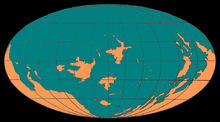
During the Ordovician, the southern continents were collected into Gondwana. Gondwana started the period in equatorial latitudes and, as the period progressed, drifted toward the South Pole.
Early in the Ordovician, the continents of Laurentia (in present-day North America), Siberia, and Baltica (present-day northern Europe) were still independent continents (since the break-up of the supercontinent Pannotia earlier), but Baltica began to move towards Laurentia later in the period, causing the Iapetus Ocean between them to shrink. The small continent Avalonia separated from Gondwana and began to move north towards Baltica and Laurentia, opening the Rheic Ocean between Gondwana and Avalonia.
The Taconic orogeny, a major mountain-building episode, was well under way in Cambrian times. In the early and middle Ordovician, temperatures were mild, but at the beginning of the Late Ordovician, from 460 to 450 Ma, volcanoes along the margin of the Iapetus Ocean spewed massive amounts of carbon dioxide, a greenhouse gas, into the atmosphere, turning the planet into a hothouse.
Initially, sea levels were high, but as Gondwana moved south, ice accumulated into glaciers and sea levels dropped. At first, low-lying sea beds increased diversity, but later glaciation led to mass extinctions as the seas drained and continental shelves became dry land. During the Ordovician, in fact during the Tremadocian, marine transgressions worldwide were the greatest for which evidence is preserved.
These volcanic island arcs eventually collided with proto North America to form the Appalachian mountains. By the end of the Late Ordovician the volcanic emissions had stopped. Gondwana had by that time neared the South Pole and was largely glaciated.
Geochemistry
The Ordovician was a time of calcite sea geochemistry in which low-magnesium calcite was the primary inorganic marine precipitate of calcium carbonate. Carbonate hardgrounds were thus very common, along with calcitic ooids, calcitic cements, and invertebrate faunas with dominantly calcitic skeletons. Biogenic aragonite, like that composing the shells of most molluscs, dissolved rapidly on the sea floor after death.[13][14]
Unlike Cambrian times, when calcite production was dominated by microbial and non-biological processes, animals (and macroalgae) became a dominant source of calcareous material in Ordovician deposits.[15]
Climate and sea level
The Ordovician saw the highest sea levels of the Paleozoic, and the low relief of the continents led to many shelf deposits being formed under hundreds of metres of water.[15] The sea level rose more or less continuously throughout the Early Ordovician, leveling off somewhat during the middle of the period.[15] Locally, some regressions occurred, but sea level rise continued in the beginning of the Late Ordovician. Sea levels fell steadily in accord with the cooling temperatures for ~30 million years leading up to the Hirnantian glaciation. During this icy stage, sea level seems to have risen and dropped somewhat, but despite much study the details remain unresolved.[15]
As with North America and Europe, Gondwana was largely covered with shallow seas during the Ordovician. Shallow clear waters over continental shelves encouraged the growth of organisms that deposit calcium carbonates in their shells and hard parts. The Panthalassic Ocean covered much of the northern hemisphere, and other minor oceans included Proto-Tethys, Paleo-Tethys, Khanty Ocean, which was closed off by the Late Ordovician, Iapetus Ocean, and the new Rheic Ocean.
As the Ordovician progressed, we see evidence of glaciers on the land we now know as Africa and South America, which were near the South Pole at the time, and covered by ice caps.
Life

For most of the Late Ordovician life continued to flourish, but at and near the end of the period there were mass-extinction events that seriously affected planktonic forms like conodonts and graptolites. The trilobites Agnostida and Ptychopariida completely died out, and the Asaphida were much reduced. Brachiopods, bryozoans and echinoderms were also heavily affected, and the endocerid cephalopods died out completely, except for possible rare Silurian forms. The Ordovician–Silurian extinction events may have been caused by an ice age that occurred at the end of the Ordovician period, due to the expansion of the first terrestrial plants,[16] as the end of the Late Ordovician was one of the coldest times in the last 600 million years of Earth's history.
Fauna
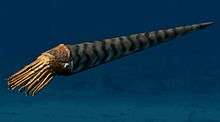
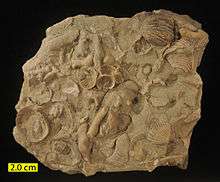
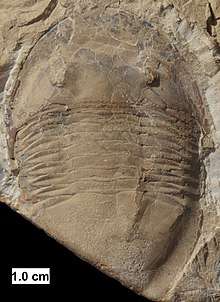
On the whole, the fauna that emerged in the Ordovician were the template for the remainder of the Palaeozoic.[15] The fauna was dominated by tiered communities of suspension feeders, mainly with short food chains. The ecological system reached a new grade of complexity far beyond that of the Cambrian fauna,[15] which has persisted until the present day.[15]
Though less famous than the Cambrian explosion, the Ordovician radiation was no less remarkable; marine faunal genera increased fourfold, resulting in 12% of all known Phanerozoic marine fauna.[17] Another change in the fauna was the strong increase in filter-feeding organisms.[18] The trilobite, inarticulate brachiopod, archaeocyathid, and eocrinoid faunas of the Cambrian were succeeded by those that dominated the rest of the Paleozoic, such as articulate brachiopods, cephalopods, and crinoids. Articulate brachiopods, in particular, largely replaced trilobites in shelf communities.[19] Their success epitomizes the greatly increased diversity of carbonate shell-secreting organisms in the Ordovician compared to the Cambrian.[19]
In North America and Europe, the Ordovician was a time of shallow continental seas rich in life. Trilobites and brachiopods in particular were rich and diverse. Although solitary corals date back to at least the Cambrian, reef-forming corals appeared in the early Ordovician, corresponding to an increase in the stability of carbonate and thus a new abundance of calcifying animals.[15]
Molluscs, which appeared during the Cambrian or even the Ediacaran, became common and varied, especially bivalves, gastropods, and nautiloid cephalopods.
Now-extinct marine animals called graptolites thrived in the oceans. Some new cystoids and crinoids appeared.
It was long thought that the first true vertebrates (fish — Ostracoderms) appeared in the Ordovician, but recent discoveries in China reveal that they probably originated in the Early Cambrian. The very first gnathostome (jawed fish) appeared in the Late Ordovician epoch.
During the Middle Ordovician there was a large increase in the intensity and diversity of bioeroding organisms. This is known as the Ordovician Bioerosion Revolution.[20] It is marked by a sudden abundance of hard substrate trace fossils such as Trypanites, Palaeosabella, Petroxestes and Osprioneides. Several groups of endobiotic symbionts appeared in the Ordovician.[21][22]
In the Early Ordovician, trilobites were joined by many new types of organisms, including tabulate corals, strophomenid, rhynchonellid, and many new orthid brachiopods, bryozoans, planktonic graptolites and conodonts, and many types of molluscs and echinoderms, including the ophiuroids ("brittle stars") and the first sea stars. Nevertheless, the arthropods remained abundant, all the Late Cambrian orders continued, and were joined by the new group Phacopida. The first evidence of land plants also appeared (see evolutionary history of life).
In the Middle Ordovician, the trilobite-dominated Early Ordovician communities were replaced by generally more mixed ecosystems, in which brachiopods, bryozoans, molluscs, cornulitids, tentaculitids and echinoderms all flourished, tabulate corals diversified and the first rugose corals appeared. The planktonic graptolites remained diverse, with the Diplograptina making their appearance. Bioerosion became an important process, particularly in the thick calcitic skeletons of corals, bryozoans and brachiopods, and on the extensive carbonate hardgrounds that appear in abundance at this time. One of the earliest known armoured agnathan ("ostracoderm") vertebrate, Arandaspis, dates from the Middle Ordovician.
Trilobites in the Ordovician were very different from their predecessors in the Cambrian. Many trilobites developed bizarre spines and nodules to defend against predators such as primitive eurypterids and nautiloids while other trilobites such as Aeglina prisca evolved to become swimming forms. Some trilobites even developed shovel-like snouts for ploughing through muddy sea bottoms. Another unusual clade of trilobites known as the trinucleids developed a broad pitted margin around their head shields.[23] Some trilobites such as Asaphus kowalewski evolved long eyestalks to assist in detecting predators whereas other trilobite eyes in contrast disappeared completely.[24] Molecular clock analyses suggest that early arachnids started living on land by the end of the Ordovician.[25]
The earliest-known octocorals date from the Ordovician.[26]
 The Upper Ordovician edrioasteroid Cystaster stellatus on a cobble from the Kope Formation in northern Kentucky. In the background is the cyclostome bryozoan Corynotrypa.
The Upper Ordovician edrioasteroid Cystaster stellatus on a cobble from the Kope Formation in northern Kentucky. In the background is the cyclostome bryozoan Corynotrypa. Fossil Mountain, west-central Utah; Middle Ordovician fossiliferous shales and limestones in the lower half.
Fossil Mountain, west-central Utah; Middle Ordovician fossiliferous shales and limestones in the lower half. Outcrop of Upper Ordovician rubbly limestone and shale, southern Indiana; College of Wooster students.
Outcrop of Upper Ordovician rubbly limestone and shale, southern Indiana; College of Wooster students.- Outcrop of Upper Ordovician limestone and minor shale, central Tennessee; College of Wooster students.
 Trypanites borings in an Ordovician hardground, southeastern Indiana.[27]
Trypanites borings in an Ordovician hardground, southeastern Indiana.[27] Petroxestes borings in an Ordovician hardground, southern Ohio.[20]
Petroxestes borings in an Ordovician hardground, southern Ohio.[20]
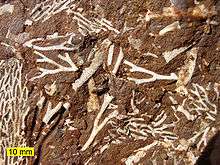 Bryozoan fossils in Ordovician kukersite oil shale, northern Estonia.
Bryozoan fossils in Ordovician kukersite oil shale, northern Estonia.- Brachiopods and bryozoans in an Ordovician limestone, southern Minnesota.
 Vinlandostrophia ponderosa, Maysvillian (Upper Ordovician) near Madison, Indiana. Scale bar is 5.0 mm.
Vinlandostrophia ponderosa, Maysvillian (Upper Ordovician) near Madison, Indiana. Scale bar is 5.0 mm.- The Ordovician cystoid Echinosphaerites (an extinct echinoderm) from northeastern Estonia; approximately 5 cm in diameter.
- Prasopora, a trepostome bryozoan from the Ordovician of Iowa.
- An Ordovician strophomenid brachiopod with encrusting inarticulate brachiopods and a bryozoan.
 The heliolitid coral Protaraea richmondensis encrusting a gastropod; Cincinnatian (Upper Ordovician) of southeastern Indiana.
The heliolitid coral Protaraea richmondensis encrusting a gastropod; Cincinnatian (Upper Ordovician) of southeastern Indiana. Zygospira modesta, atrypid brachiopods, preserved in their original positions on a trepostome bryozoan; Cincinnatian (Upper Ordovician) of southeastern Indiana.
Zygospira modesta, atrypid brachiopods, preserved in their original positions on a trepostome bryozoan; Cincinnatian (Upper Ordovician) of southeastern Indiana.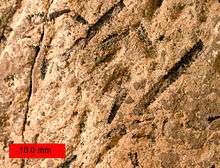 Graptolites (Amplexograptus) from the Ordovician near Caney Springs, Tennessee.
Graptolites (Amplexograptus) from the Ordovician near Caney Springs, Tennessee.
Flora
Green algae were common in the Late Cambrian (perhaps earlier) and in the Ordovician. Terrestrial plants probably evolved from green algae, first appearing as tiny non-vascular forms resembling liverworts. Fossil spores from land plants have been identified in uppermost Ordovician sediments.
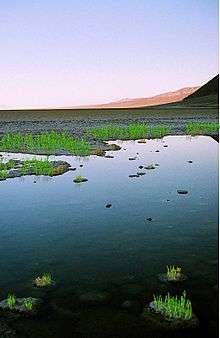
Among the first land fungi may have been arbuscular mycorrhiza fungi (Glomerales), playing a crucial role in facilitating the colonization of land by plants through mycorrhizal symbiosis, which makes mineral nutrients available to plant cells; such fossilized fungal hyphae and spores from the Ordovician of Wisconsin have been found with an age of about 460 million years ago, a time when the land flora most likely only consisted of plants similar to non-vascular bryophytes.[28]
End of the period
The Ordovician came to a close in a series of extinction events that, taken together, comprise the second largest of the five major extinction events in Earth's history in terms of percentage of genera that became extinct. The only larger one was the Permian–Triassic extinction event.
The extinctions occurred approximately 447–444 million years ago and mark the boundary between the Ordovician and the following Silurian Period. At that time all complex multicellular organisms lived in the sea, and about 49% of genera of fauna disappeared forever; brachiopods and bryozoans were greatly reduced, along with many trilobite, conodont and graptolite families.
The most commonly accepted theory is that these events were triggered by the onset of cold conditions in the late Katian, followed by an ice age, in the Hirnantian faunal stage, that ended the long, stable greenhouse conditions typical of the Ordovician.
The ice age was possibly not long-lasting. Oxygen isotopes in fossil brachiopods show its duration may have been only 0.5 to 1.5 million years.[29] Other researchers (Page et al.) estimate more temperate conditions did not return until the late Silurian.
The late Ordovician glaciation event was preceded by a fall in atmospheric carbon dioxide (from 7000 ppm to 4400 ppm).[30][31] The dip was triggered by a burst of volcanic activity that deposited new silicate rocks, which draw CO2 out of the air as they erode.[31] This selectively affected the shallow seas where most organisms lived. As the southern supercontinent Gondwana drifted over the South Pole, ice caps formed on it, which have been detected in Upper Ordovician rock strata of North Africa and then-adjacent northeastern South America, which were south-polar locations at the time.
As glaciers grew, the sea level dropped, and the vast shallow intra-continental Ordovician seas withdrew, which eliminated many ecological niches. When they returned, they carried diminished founder populations that lacked many whole families of organisms. They then withdrew again with the next pulse of glaciation, eliminating biological diversity with each change.[32] Species limited to a single epicontinental sea on a given landmass were severely affected.[14] Tropical lifeforms were hit particularly hard in the first wave of extinction, while cool-water species were hit worst in the second pulse.[14]
Those species able to adapt to the changing conditions survived to fill the ecological niches left by the extinctions.
At the end of the second event, melting glaciers caused the sea level to rise and stabilise once more. The rebound of life's diversity with the permanent re-flooding of continental shelves at the onset of the Silurian saw increased biodiversity within the surviving Orders.
An alternate extinction hypothesis suggested that a ten-second gamma-ray burst could have destroyed the ozone layer and exposed terrestrial and marine surface-dwelling life to deadly ultraviolet radiation and initiated global cooling.[33]
Recent work considering the sequence stratigraphy of the Late Ordovician argues that the mass extinction was a single protracted episode lasting several hundred thousand years, with abrupt changes in water depth and sedimentation rate producing two pulses of last occurrences of species.[34]
References
- Haq, B. U.; Schutter, SR (2008). "A Chronology of Paleozoic Sea-Level Changes". Science. 322 (5898): 64–68. Bibcode:2008Sci...322...64H. doi:10.1126/science.1161648. PMID 18832639.
- "Ordovician". Dictionary.com Unabridged. Random House.
- "International Chronostratigraphic Chart v.2015/01" (PDF). International Commission on Stratigraphy. January 2015.
- Charles Lapworth (1879) "On the Tripartite Classification of the Lower Palaeozoic Rocks," Geological Magazine, new series, 6 : 1-15. From pp. 13-14: "North Wales itself — at all events the whole of the great Bala district where Sedgwick first worked out the physical succession among the rocks of the intermediate or so-called Upper Cambrian or Lower Silurian system; and in all probability much of the Shelve and the Caradoc area, whence Murchison first published its distinctive fossils — lay within the territory of the Ordovices; … Here, then, have we the hint for the appropriate title for the central system of the Lower Palaeozoics. It should be called the Ordovician System, after this old British tribe."
- "New type of meteorite linked to ancient asteroid collision". Science Daily. 15 June 2016. Retrieved 20 June 2016.
- Details on the Dapingian are available at Wang, X.; Stouge, S.; Chen, X.; Li, Z.; Wang, C. (2009). "Dapingian Stage: standard name for the lowermost global stage of the Middle Ordovician Series". Lethaia. 42 (3): 377–380. doi:10.1111/j.1502-3931.2009.00169.x.
- Ordovician stratigraphy
- Ogg; Ogg; Gradstein, eds. (2008). The Concise Geological Timescale.
- Lindskog, A.; Costa, M. M.; Rasmussen, C.M.Ø.; Connelly, J. N.; Eriksson, M. E. (2017-01-24). "Refined Ordovician timescale reveals no link between asteroid breakup and biodiversification". Nature Communications. 8: 14066. doi:10.1038/ncomms14066. ISSN 2041-1723. PMC 5286199. PMID 28117834.
- Heck, Philipp R.; Schmitz, Birger; Baur, Heinrich; Halliday, Alex N.; Wieler, Rainer (2004). "Fast delivery of meteorites to Earth after a major asteroid collision". Nature. 430 (6997): 323–5. Bibcode:2004Natur.430..323H. doi:10.1038/nature02736. PMID 15254530.
- Haack, Henning; Farinella, Paolo; Scott, Edward R. D.; Keil, Klaus (1996). "Meteoritic, Asteroidal, and Theoretical Constraints on the 500 MA Disruption of the L Chondrite Parent Body". Icarus. 119 (1): 182–91. Bibcode:1996Icar..119..182H. doi:10.1006/icar.1996.0010.
- Korochantseva, Ekaterina V.; Trieloff, Mario; Lorenz, Cyrill A.; Buykin, Alexey I.; Ivanova, Marina A.; Schwarz, Winfried H.; Hopp, Jens; Jessberger, Elmar K. (2007). "L-chondrite asteroid breakup tied to Ordovician meteorite shower by multiple isochron 40Ar-39Ar dating". Meteoritics & Planetary Science. 42 (1): 113–30. Bibcode:2007M&PS...42..113K. doi:10.1111/j.1945-5100.2007.tb00221.x.
- Stanley, S.; Hardie, L. (1998). "Secular oscillations in the carbonate mineralogy of reef-building and sediment-producing organisms driven by tectonically forced shifts in seawater chemistry". Palaeogeography, Palaeoclimatology, Palaeoecology. 144 (1–2): 3–19. Bibcode:1998PPP...144....3S. doi:10.1016/S0031-0182(98)00109-6.
- Stanley, S. M.; Hardie, L. A. (1999). "Hypercalcification; paleontology links plate tectonics and geochemistry to sedimentology". GSA Today. 9: 1–7.
- Munnecke, A.; Calner, M.; Harper, D. A. T.; Servais, T. (2010). "Ordovician and Silurian sea-water chemistry, sea level, and climate: A synopsis". Palaeogeography, Palaeoclimatology, Palaeoecology. 296 (3–4): 389–413. doi:10.1016/j.palaeo.2010.08.001.
- Humble moss helped to cool Earth and spurred on life
- Dixon, Dougal; et al. (2001). Atlas of Life on Earth. New York: Barnes & Noble Books. p. 87. ISBN 978-0-7607-1957-2.
- Palaeos Paleozoic : Ordovician : The Ordovician Period Archived 2007-12-21 at the Wayback Machine
- Cooper, John D.; Miller, Richard H.; Patterson, Jacqueline (1986). A Trip Through Time: Principles of Historical Geology. Columbus: Merrill Publishing Company. pp. 247, 255–259. ISBN 978-0-675-20140-7.
- Wilson, M. A.; Palmer, T. J. (2006). "Patterns and processes in the Ordovician Bioerosion Revolution" (PDF). Ichnos. 13 (3): 109–112. Bibcode:1998Ichno...6..141C. doi:10.1080/10420940600850505. Archived from the original (PDF) on 2008-12-16.
- Vinn, O.; Mõtus, M.-A. (2012). "Diverse early endobiotic coral symbiont assemblage from the Katian (Late Ordovician) of Baltica". Palaeogeography, Palaeoclimatology, Palaeoecology. 321–322: 137–141. doi:10.1016/j.palaeo.2012.01.028. Retrieved 2014-06-11.
- Vinn, O., Wilson, M.A., Mõtus, M.-A. and Toom, U. (2014). "The earliest bryozoan parasite: Middle Ordovician (Darriwilian) of Osmussaar Island, Estonia". Palaeogeography, Palaeoclimatology, Palaeoecology. 414: 129–132. doi:10.1016/j.palaeo.2014.08.021. Retrieved 2014-01-09.CS1 maint: multiple names: authors list (link)
- "Palaeos Paleozoic : Ordovician : The Ordovician Period". April 11, 2002. Archived from the original on December 21, 2007.
- A Guide to the Orders of Trilobites
- Garwood, Russell J.; Sharma, Prashant P.; Dunlop, Jason A.; Giribet, Gonzalo (2014). "A Paleozoic Stem Group to Mite Harvestmen Revealed through Integration of Phylogenetics and Development". Current Biology. 24 (9): 1017–1023. Bibcode:1996CBio....6.1213A. doi:10.1016/j.cub.2014.03.039. PMID 24726154. Retrieved April 17, 2014.
- Bergström, Stig M.; Bergström, Jan; Kumpulainen, Risto; Ormö, Jens; Sturkell, Erik (2007). "Maurits Lindström – A renaissance geoscientist". GFF. 129 (2): 65–70. doi:10.1080/11035890701292065.
- Wilson, M. A.; Palmer, T. J. (2001). "Domiciles, not predatory borings: a simpler explanation of the holes in Ordovician shells analyzed by Kaplan and Baumiller, 2000". PALAIOS. 16 (5): 524–525. doi:10.1669/0883-1351(2001)016<0524:DNPBAS>2.0.CO;2.
- Redecker, D.; Kodner, R.; Graham, L. E. (2000). "Glomalean fungi from the Ordovician". Science. 289 (5486): 1920–1921. Bibcode:2000Sci...289.1920R. doi:10.1126/science.289.5486.1920. PMID 10988069.
- Stanley, Steven M. (1999). Earth System History. New York: W.H. Freeman and Company. pp. 358, 360. ISBN 978-0-7167-2882-5.
- Young, Seth A.; Saltzman, Matthew R.; Ausich, William I.; Desrochers, André; Kaljo, Dimitri (2010). "Did changes in atmospheric CO2 coincide with latest Ordovician glacial–interglacial cycles?". Palaeogeography, Palaeoclimatology, Palaeoecology. 296 (3–4): 376–388. doi:10.1016/j.palaeo.2010.02.033.
- Jeff Hecht, High-carbon ice age mystery solved, New Scientist, 8 March 2010 (retrieved 30 June 2014)
- Emiliani, Cesare. (1992). Planet Earth : Cosmology, Geology, & the Evolution of Life & the Environment (Cambridge University Press) p. 491
- Melott, Adrian; et al. (2004). "Did a gamma-ray burst initiate the late Ordovician mass extinction?". International Journal of Astrobiology. 3 (1): 55–61. arXiv:astro-ph/0309415. Bibcode:2004IJAsB...3...55M. doi:10.1017/S1473550404001910. hdl:1808/9204.
- Holland, Steven M; Patzkowsky, Mark E (2015). "The stratigraphy of mass extinction". Palaeontology. 58 (5): 903–924. doi:10.1111/pala.12188.
External links
| Wikisource has original works on the topic: Paleozoic#Ordovician |
| Wikimedia Commons has media related to Ordovician. |
- Ogg, Jim (June 2004). "Overview of Global Boundary Stratotype Sections and Points (GSSP's)". Archived from the original on 2006-04-23. Retrieved 2006-04-30.
- Mehrtens, Charlotte. "Chazy Reef at Isle La Motte". An Ordovician reef in Vermont.
- Ordovician fossils of the famous Cincinnatian Group
- The Dry Dredgers, an active group of amateur paleontologists in the Cincinnati area
- Ordovician (chronostratigraphy scale)